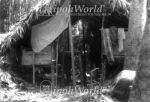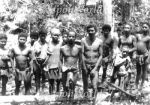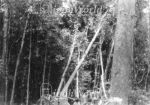We've tried to ensure the information displayed here is as accurate as possible. Should there be any inaccuracies, we would be grateful if you could let us know at info@ipohworld.org . All images and content are copyright.
(Please click on the thumbnail for a bigger image.)
Fort Kemar - The Building Of A Malayan Jungle Fort - Part 4



It took nearly four days to march to the area in which we were to locate the fort and upon arrival we set up camp beside the Sungei Temengor about 12 miles south of Kampong Temengor, an isolated abandoned Malay kampong surrounded by jungle. Our camp site, had, at some time in the not-too-distant past, been an Orang Asli ladang and required little clearing to enable us to receive the much needed airdrop of food on the following morning. We wasted no time and on the morning after the airdrop, leaving the main body to clear a larger airdrop zone (DZ)and a helicopter landing pad (LZ), Gary Lockington and I took a small party and commenced our search for a suitable site for the fort. In fact, the area we had already marked on our maps during the planning of the operation proved to be ideal. It was a flat area on a narrow strip of land between the Temengor and one of its tributaries - the Sungei Kemar - which ran parallel to it for about 3 miles. At one point the two rivers curved towards each other making a bottle neck just wide enough for the fort, but then widening again to provide a large flat area eminently suitable for an air drop zone and a helicopter landing pad. The land was 30 or 40 feet above the two rivers and not overlooked from any side. It was, therefore, easily defended and provided an excellent supply of clean water.
In our absence, the working party at the camp had completed the clearing of the DZ and LZ and we were able to receive a second airdrop of food, supplies and tools required for the fort construction on the 25th February. It also enabled Lt.Col. Sloane, commanding officer of 22 SAS, to come in by helicopter on the 26th February to visit his squadron HQ in the vicinity of my camp, the main body of the Squadron having been deployed in the surrounding areas. He returned on the same day taking with him Gary Lockington who, after he had briefed me and after we had agreed on the location of the fort, returned to our camp in Grik.
During the initial stages of the operation, the SAS, commanded by a Captain Dare Newell, experienced considerable difficulties with their wireless sets. Initially, their powerful transmitter, operating from our camp in Grik had overridden our police radio signals and they had had to move it. A few days later, every one of the 62 sets carried by their 4 troops operating independently in the jungle and the 68 set at their squadron HQ in our camp was defective. Not only could the patrols not communicate with their squadron HQ but squadron HQ could not communicate with their Regimental HQ and they were reduced to having to use our police sets and network. This proved to be very difficult since all sets were in constant use during daylight hours, largely due to the weakness of our signals from the area in which our signallers worked and it required enormous patience and persistence on their part to transmit and receive long messages, usually by morse code, which, although time consuming, was more clearly received than verbal communication, which for most of the time was impossible. New sets were quickly acquired by airdrop to the SAS and the situation settled down. Even so, given the primitive sets of those days communications from deep jungle were always tenuous.
Now that we had the essential tools, work on the fort began in earnest and I decided that we would remain in our original camp until the fort site had been sufficiently cleared to allow us to move there. Each day, leaving one section to guard the camp and to continue to make it more comfortable, the fort working party, consisting of my other two sections, marched there after an early breakfast and returned in the evening before dark. It was a demanding regime but it did mean that every man would be given one day of light duties in three.
Our first task was to completely clear the fort area of jungle - a formidable task given the number and size of some of the vast trees and that it was to be done by hand. My Malay boys were completely at home in this environment. Clearing and felling trees, constructing houses of timber and roofing them with attap was second nature to them, but without the large workforce provided by the Orang Asli it would have taken months - but we need not have worried. Within the first few days of our arrival small groups trickled in and the trickle turned into a flood - some led in by the SAS and others, who had heard of it on the jungle grapevine had come out of curiosity - men, women and children, all hugely enthusiastic and keen to enlist in one form or another. They are a very friendly, happy and simple people and it took no time to establish a rapport with them. When we explained that we had to come to build a camp, for which they would be paid to help us, and to provide them with a school, a medical centre and a shop, their enthusiasm knew no bounds. We enlisted those we needed and welcomed their many camp followers.
The photographs show the "basha" which was the home of Dennis during the building of the fort (left), a selection of the camp followers, the Asli workforce (centre) and felling trees showing the sort of terrain that had to be cleared.
To go to Part 5, click here.